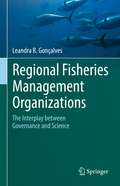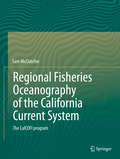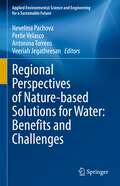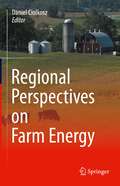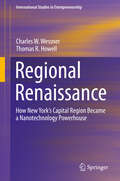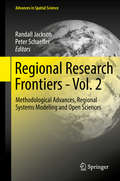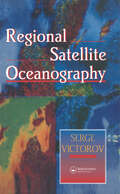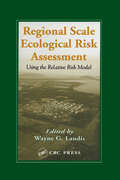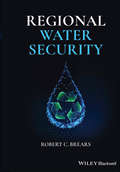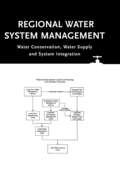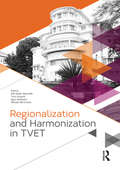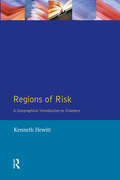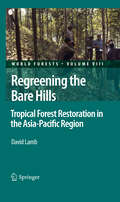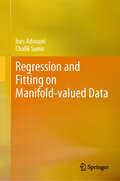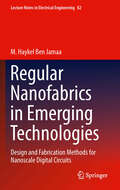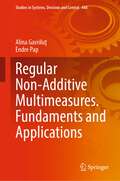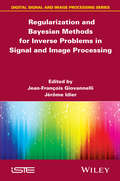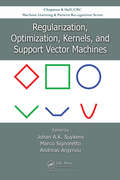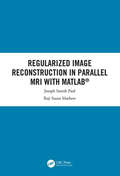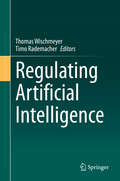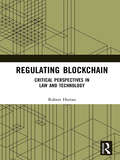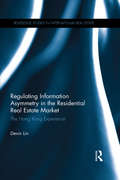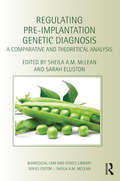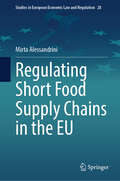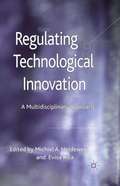- Table View
- List View
Regional Fisheries Management Organizations: The interplay between governance and science
by Leandra R. GonçalvesThis book analyzes empirical data from three specific Regional Fisheries Management Organizations (RFMOs) designed to establish rules for the conservation and management of fish stocks in the ocean, in order to assess their effectiveness in converting science into policy for the recovery and maintenance of fishery populations. The three RFMOs discussed are the CCAMLR (Convention for the Conservation of Antarctic Marine Living Resources), the ICCAT (International Commission for the Conservation of Atlantic Tunas) and the CCSBT (Commission for the Conservation of Southern Bluefin Tuna). The book seeks to understand when governments choose to listen to science, and establishes a framework to examine the institutional designs currently in place to accommodate RFMO policy suggestions and the conditions under which they are implemented successfully. The study will be of interest to academics and professionals broadly interested in global environmental governance and international relations, and will specifically appeal to policymakers, conservationists, and environmental researchers interested in fishery management and policy at the global and regional scale. Gonçalves provides an accessible and comprehensive analysis of RMFOs. She offers valuable insights into the role of science and politics in shaping sustainable fisheries policies for the open oceans. ---Peter M Haas, Professor Department of Political Science, University of Massachusetts AmherstAs envisaged by the UN Decade of Ocean proclamation, this book is an important and sincere effort, hopefully to be accompanied by many others to come during this promising decade, that will help to build a common framework to ensure that ocean science can support countries and the international community in creating improved conditions for the sustainable development of our cherished Ocean.---Fabio H. Hazin - Professor at Federal Rural University of Pernambuco, Brazil
Regional Fisheries Oceanography of the California Current System
by Sam McclatchieThe California Current System is one of the best studied ocean regions of the world, and the level of oceanographic information available is perhaps only surpassed by the northeast and northwest Atlantic The current literature (later than 1993) offers no comprehensive, integrated review of the regional fisheries oceanography of the California Current System. This volume summarizes information of more than 60-year California Cooperative Oceanic Fisheries Investigation (CalCOFI) While providing a large bibliography, the intent was to extract themes relevant to current research rather than to prepare a compendious review of the literature The work presents a useful review and reference point for multidisciplinary fisheries scientists and biological oceanographers new to working in the California Current System, and to specialists wishing to access information outside their core areas of expertise. In addition it aims to deliver an up to date reference to the current state of knowledge of fisheries oceanography in the California Current System.
Regional Perspectives of Nature-based Solutions for Water: Benefits and Challenges (Applied Environmental Science and Engineering for a Sustainable Future)
by Veeriah Jegatheesan Nevelina Pachova Perlie Velasco Antonina TorrensNature-based solutions (NbS) are solutions inspired or supported by nature. They include ecosystem conservation and restoration measures, as well as the creation or enhancement of natural processes in man-made ecosystems, such as cities. Recent interest in NbS has emphasized their importance for urban water management and cities across the world have begun to experiment with them. Experiences from different contexts, however, are not adequately captured and understood. This book aims to address this gap by compiling case studies and reviews that explore NbS for urban water management from different regions and perspectives and highlight emerging challenges and opportunities for harnessing their potential.
Regional Perspectives on Farm Energy
by Daniel CiolkoszThis book examines the characteristics and opportunities for farm energy in the northeast quadrant of the United States, with attention to energy use, strategic energy management, and energy production by solar, wind, biomass, and other means. Throughout, the distinct characteristics of the region and their impact on energy solutions are discussed, and the outlook for future energy strategies is considered. Farm energy production and use are topics of increasing interest, as the need for improved efficiency and the opportunity for sustainable energy production both drive agricultural enterprises to reduce energy use and pursue opportunities for renewable energy production and use on the farm. However, the unique regional characteristics of agriculture make it challenging to apply a single approach to all situations.
Regional Renaissance: How New York’s Capital Region Became a Nanotechnology Powerhouse (International Studies in Entrepreneurship #42)
by Charles W. Wessner Thomas R. HowellThis book examines ways in which formerly prosperous regions can renew their economy during and after a period of industrial and economic recession. Using New York’s Capital Region (i.e., Albany, Troy, Schenectady, etc.) as a case study, the authors show how entrepreneurship, innovation, investment in education, research and political collaboration are critical to achieving regional success. In this way, the book provides other regions and nations with a real-life model for successful economic development. In the past half century, the United States and other nations have seen an economic decline of formerly prosperous regions as a result of new technology and globalization. One of the hardest-hit United States regions is Upstate New York or “the Capital Region”; it experienced a demoralizing hemorrhage of manufacturing companies, jobs and people to other regions and countries. To combat this, the region, with the help of state leaders, mounted a decades-long effort to renew and restore the region’s economy with a particular focus on nanotechnology. As a result, New York’s Capital Region successfully added thousands of well-paying, skill-intensive manufacturing jobs. New York’s success story serves as a model for economic development for policy makers that includes major public investments in educational institutions and research infrastructure; partnerships between academia, industry and government; and creation of frameworks for intra-regional collaboration by business, government, and academic actors. Featuring recommendations for best practices in regional development policy, this book is appropriate for scholars, students, researchers and policy makers in regional development, innovation, R&D policy, economic development and economic growth.
Regional Research Frontiers - Vol. 2
by Randall Jackson Peter SchaefferThis is the second volume in a two-part series on frontiers in regional research. It identifies methodological advances as well as trends and future developments in regional systems modelling and open science. Building on recent methodological and modelling advances, as well as on extensive policy-analysis experience, top international regional scientists identify and evaluate emerging new conceptual and methodological trends and directions in regional research. Topics such as dynamic interindustry modelling, computable general equilibrium models, exploratory spatial data analysis, geographic information science, spatial econometrics and other advanced methods are the central focus of this book. The volume provides insights into the latest developments in object orientation, open source, and workflow systems, all in support of open science. It will appeal to a wide readership, from regional scientists and economists to geographers, quantitatively oriented regional planners and other related disciplines. It offers a source of relevant information for academic researchers and policy analysts in government, and is also suitable for advanced teaching courses on regional and spatial science, economics and political science.
Regional Satellite Oceanography
by Serge VictorovThis work addresses the whole range of problems relating to the application of satellite technology to studies of regional seas and sea phenomona - the Gulf Stream, the Kuroshia Current - and coastal zones. It argues that to emphasize global applications is to fail to take into account fundamental idiosyncracies specific to the regional perspective
Regional Scale Ecological Risk Assessment: Using the Relative Risk Model
by Wayne G. LandisAs debates over how relative risk can be used to shape landscape-scale environmental management intensify, Regional-Scale Risk Assessment demonstrates the capabilities of RRM using nine case studies in the Pacific Northwest, Pennsylvania, Brazil, and Tasmania. The authors use a process of ranking and filters to interrelate different kinds of risks
Regional Water Security
by Robert C. BrearsRegional Water Security provides new research on policy innovations that promote the application of demand management and green infrastructure (GI) in managing water resources across regions sustainably. In particular, with regional water security around the world at risk from climatic and non-climatic challenges impacting water quantity and water quality, this book, in addition to providing examples of demand management and GI being implemented in various locations globally, contains in-depth case studies that illustrate how regions, of differing climates, lifestyles, and income levels, have implemented policy innovations that promote the application of demand management and GI to achieve regional water security for humans while protecting and restoring the natural environment. Regional Water Security will be of interest to regional water resource managers, town and regional planners, resource conservation managers, policymakers, international companies, and organizations as well as environmental NGOs, researchers, and graduate and undergraduate students.
Regional Water System Management: Water Conservation, Water Supply and System Integration
by Enrique CabreraThe spectacular industrial and economic development of the twentieth century was achieved at a considerable environmental cost. The increasingly precarious position of water, the most valuable of natural resources, reflects this trend. Today we have come to realise that concepts of sustainable development need to
Regionalization and Harmonization in TVET: Proceedings of the 4th UPI International Conference on Technical and Vocational Education and Training (TVET 2016), November 15-16, 2016, Bandung, Indonesia
by Ade Gafar Abdullah, Tutin Aryanti, Agus Setiawan & Maizam Binti AliasRegionalization and Harmonization in TVET contains the papers presented at the 4th UPI International Conference on Technical and Vocational Education and Training (TVET 2016, Bandung, Indonesia, 15-16 November 2016). 1. Standardization in Regionalization and Harmonization2. Skill and Personal Development3. Social and Cultural Issues4. Teaching Innovations in TVET5. Innovations in Engineering and Education.
Regions of Risk: A Geographical Introduction to Disasters (Themes In Resource Management)
by Kenneth HewittAn introduction to hazards, human vulnerability and disaster, paying particular attention to the more severe or novel risks and disaster that affect the general public. The book is split into two parts, the first of which gives an overview of the field of risk and disaster in terms of three perspectives: hazards perspective; vulnerability perspective and the active perspective. The second part illustrates and develops these ideas in relation to some of the more severe dangers and disasters of the twentieth century, for example, earthquake risk, cities at risk and the civil disasters of war.
Regreening the Bare Hills
by David LambIn Regreening the Bare Hills: Tropical Forest Restoration in the Asia-Pacific Region, David Lamb explores how reforestation might be carried out both to conserve biological diversity and to improve the livelihoods of the rural poor. While both issues have attracted considerable attention in recent years, this book takes a significant step, by integrating ecological and silvicultural knowledge within the context of the social and economic issues that can determine the success or failure of tropical forest landscape restoration. Describing new approaches to the reforestation of degraded lands in the Asia-Pacific tropics, the book reviews current approaches to reforestation throughout the region, paying particular attention to those which incorporate native species - including in multi-species plantations. It presents case studies from across the Asia-Pacific region and discusses how the silvicultural methods needed to manage these 'new' plantations will differ from conventional methods. It also explores how reforestation might be made more attractive to smallholders and how trade-offs between production and conservation are most easily made at a landscape scale. The book concludes with a discussion of how future forest restoration may be affected by some current ecological and socio-economic trends now underway. The book represents a valuable resource for reforestation managers and policy makers wishing to promote these new silvicultural approaches, as well as for conservationists, development experts and researchers with an interest in forest restoration. Combining a theoretical-research perspective with practical aspects of restoration, the book will be equally valuable to practitioners and academics, while the lessons drawn from these discussions will have relevance elsewhere throughout the tropics.
Regression and Fitting on Manifold-valued Data
by Ines Adouani Chafik SamirThis book introduces in a constructive manner a general framework for regression and fitting methods for many applications and tasks involving data on manifolds. The methodology has important and varied applications in machine learning, medicine, robotics, biology, computer vision, human biometrics, nanomanufacturing, signal processing, and image analysis, etc. The first chapter gives motivation examples, a wide range of applications, raised challenges, raised challenges, and some concerns. The second chapter gives a comprehensive exploration and step-by-step illustrations for Euclidean cases. Another dedicated chapter covers the geometric tools needed for each manifold and provides expressions and key notions for any application for manifold-valued data. All loss functions and optimization methods are given as algorithms and can be easily implemented. In particular, many popular manifolds are considered with derived and specific formulations. The same philosophy is used in all chapters and all novelties are illustrated with intuitive examples. Additionally, each chapter includes simulations and experiments on real-world problems for understanding and potential extensions for a wide range of applications.
Regular Nanofabrics in Emerging Technologies
by M. Haykel Ben JamaaRegular Nanofabrics in Emerging Technologies gives a deep insight into both fabrication and design aspects of emerging semiconductor technologies, that represent potential candidates for the post-CMOS era. Its approach is unique, across different fields, and it offers a synergetic view for a public of different communities ranging from technologists, to circuit designers, and computer scientists. The book presents two technologies as potential candidates for future semiconductor devices and systems and it shows how fabrication issues can be addressed at the design level and vice versa. The reader either for academic or research purposes will find novel material that is explained carefully for both experts and non-initiated readers. Regular Nanofabrics in Emerging Technologies is a survey of post-CMOS technologies. It explains processing, circuit and system level design for people with various backgrounds.
Regular Non-Additive Multimeasures. Fundaments and Applications (Studies in Systems, Decision and Control #448)
by Endre Pap Alina GavriluţThis book is intended to be an exhaustive study on regularity and other properties of continuity for different types of non-additive multimeasures and with respect to different types of topologies. The book is addressed to graduate and postgraduate students, teachers and all researchers in mathematics, but not only. Since the notions and results offered by this book are closely related to various notions of the theory of probability, this book will be useful to a wider category of readers, using multivalued analysis techniques in areas such as control theory and optimization, economic mathematics, game theory, decision theory, etc. Measure and integration theory developed during the early years of the 20th century is one of the most important contributions to modern mathematical analysis, with important applications in many fields. In the last years, many classical problems from measure theory have been treated in the non-additive case and also extended in the set-valued case. The property of regularity is involved in many results of mathematical analysis, due to its applications in probability theory, stochastic processes, optimal control problems, dynamical systems, Markov chains, potential theory etc.
Regularization and Bayesian Methods for Inverse Problems in Signal and Image Processing
by Jean-Fran?ois Giovannelli Jér Me IdierThe focus of this book is on "ill-posed inverse problems". These problems cannot be solved only on the basis of observed data. The building of solutions involves the recognition of other pieces of a priori information. These solutions are then specific to the pieces of information taken into account. Clarifying and taking these pieces of information into account is necessary for grasping the domain of validity and the field of application for the solutions built. For too long, the interest in these problems has remained very limited in the signal-image community. However, the community has since recognized that these matters are more interesting and they have become the subject of much greater enthusiasm. From the application field's point of view, a significant part of the book is devoted to conventional subjects in the field of inversion: biological and medical imaging, astronomy, non-destructive evaluation, processing of video sequences, target tracking, sensor networks and digital communications. The variety of chapters is also clear, when we examine the acquisition modalities at stake: conventional modalities, such as tomography and NMR, visible or infrared optical imaging, or more recent modalities such as atomic force imaging and polarized light imaging.
Regularization, Optimization, Kernels, and Support Vector Machines (Chapman & Hall/CRC Machine Learning & Pattern Recognition)
by Johan A. K. Suykens Marco Signoretto Andreas ArgyriouRegularization, Optimization, Kernels, and Support Vector Machines offers a snapshot of the current state of the art of large-scale machine learning, providing a single multidisciplinary source for the latest research and advances in regularization, sparsity, compressed sensing, convex and large-scale optimization, kernel methods, and support vecto
Regularized Image Reconstruction in Parallel MRI with MATLAB
by Joseph Suresh Paul Raji Susan MathewRegularization becomes an integral part of the reconstruction process in accelerated parallel magnetic resonance imaging (pMRI) due to the need for utilizing the most discriminative information in the form of parsimonious models to generate high quality images with reduced noise and artifacts. Apart from providing a detailed overview and implementation details of various pMRI reconstruction methods, Regularized image reconstruction in parallel MRI with MATLAB examples interprets regularized image reconstruction in pMRI as a means to effectively control the balance between two specific types of error signals to either improve the accuracy in estimation of missing samples, or speed up the estimation process. The first type corresponds to the modeling error between acquired and their estimated values. The second type arises due to the perturbation of k-space values in autocalibration methods or sparse approximation in the compressed sensing based reconstruction model. Features: Provides details for optimizing regularization parameters in each type of reconstruction. Presents comparison of regularization approaches for each type of pMRI reconstruction. Includes discussion of case studies using clinically acquired data. MATLAB codes are provided for each reconstruction type. Contains method-wise description of adapting regularization to optimize speed and accuracy. This book serves as a reference material for researchers and students involved in development of pMRI reconstruction methods. Industry practitioners concerned with how to apply regularization in pMRI reconstruction will find this book most useful.
Regulating Artificial Intelligence
by Thomas Wischmeyer Timo RademacherThis book assesses the normative and practical challenges for artificial intelligence (AI) regulation, offers comprehensive information on the laws that currently shape or restrict the design or use of AI, and develops policy recommendations for those areas in which regulation is most urgently needed. By gathering contributions from scholars who are experts in their respective fields of legal research, it demonstrates that AI regulation is not a specialized sub-discipline, but affects the entire legal system and thus concerns all lawyers. Machine learning-based technology, which lies at the heart of what is commonly referred to as AI, is increasingly being employed to make policy and business decisions with broad social impacts, and therefore runs the risk of causing wide-scale damage. At the same time, AI technology is becoming more and more complex and difficult to understand, making it harder to determine whether or not it is being used in accordance with the law. In light of this situation, even tech enthusiasts are calling for stricter regulation of AI. Legislators, too, are stepping in and have begun to pass AI laws, including the prohibition of automated decision-making systems in Article 22 of the General Data Protection Regulation, the New York City AI transparency bill, and the 2017 amendments to the German Cartel Act and German Administrative Procedure Act. While the belief that something needs to be done is widely shared, there is far less clarity about what exactly can or should be done, or what effective regulation might look like. The book is divided into two major parts, the first of which focuses on features common to most AI systems, and explores how they relate to the legal framework for data-driven technologies, which already exists in the form of (national and supra-national) constitutional law, EU data protection and competition law, and anti-discrimination law. In the second part, the book examines in detail a number of relevant sectors in which AI is increasingly shaping decision-making processes, ranging from the notorious social media and the legal, financial and healthcare industries, to fields like law enforcement and tax law, in which we can observe how regulation by AI is becoming a reality.
Regulating Blockchain: Critical Perspectives in Law and Technology
by Robert HerianAs the distributed architecture underpinning the initial Bitcoin anarcho-capitalist, libertarian project, 'blockchain' entered wider public imagination and vocabulary only very recently. Yet in a short space of time it has become more mainstream and synonymous with a spectacular variety of commercial and civic 'problem'/'solution' concepts and ideals. From commodity provenance, to electoral fraud prevention, to a wholesale decentralisation of power and the banishing of the exploitative practices of 'middlemen', blockchain stakeholders are nothing short of evangelical in their belief that it is a force for good. For these reasons and more the technology has captured the attention of entrepreneurs, venture capitalists, global corporations and governments the world over. Blockchain may indeed offer a unique technical opportunity to change cultures of transparency and trust within cyberspace, and as ‘revolutionary’ and ‘disruptive’ has the potential to shift global socioeconomic and political conventions. But as a yet largely unregulated, solutionist-driven phenomenon, blockchain exists squarely within the boundaries of capitalist logic and reason, fast becoming central to the business models of many sources of financial and political power the technology was specifically designed to undo, and increasingly allied to neoliberal strategies with scant regard for collective, political or democratic accountability in the public interest. Regulating Blockchain casts a critical eye over the technology, its ‘ecosystem’ of stakeholders, and offers a challenge to the prevailing discourse proclaiming it to be the great techno-social enabler of our times.
Regulating Information Asymmetry in the Residential Real Estate Market: The Hong Kong Experience (Routledge Studies in International Real Estate)
by Devin LinThis book conducts a detailed examination of the current form of the Hong Kong residential property regulatory system: the 2013 Residential Properties (Firsthand Sales) Ordinance (Cap 621). The author sheds light on how the new legislation promotes a number of values including information symmetry, consumer protection, the free market and business efficacy. It provides a detailed account of how the regulatory mechanism has evolved over the past three decades to catch unconsscionable sales tactics (such as selective information and/or misrepresentation of location, size, completion date and past transactions) and monitor sales practices in order to protect the interests of stakeholders in this ever-changing first-hand residential property market. This book breaks down this complicated subject matter by focusing a number of chapters each on a specific attribute of the residential property on sale. It then examines the various channels through which the information is communicated to the prospective buyer and discusses misrepresentation of the key information in sales of residential properties as criminal liability.The tension between consumer’s rights on one hand and the pursuit of free market principles on the other is but one example of the conflicting values thoroughly discussed in the book, others include superstition vs. modernization and clarity vs. flexibility. Aimed at those with an interest in consumer protection and transparency-orientated legislation in commercialized real estate transactions, this book seeks to provide an in-depth discussion of the latest trends and directions of travel.
Regulating Pre-Implantation Genetic Diagnosis: A Comparative and Theoretical Analysis (Biomedical Law and Ethics Library)
by Sheila A.M. McLean Sarah EllistonThe successful achievement of pregnancies following pre-implantation genetic diagnosis (PGD) was first reported in April 1990. The technology is often used for patients who are at substantial risk of conceiving a pregnancy affected by a known genetic disorder, however from this technology other more controversial uses have arisen such as HLA typing to save the life of a sibling, gender selection for social reasons, the prevention of late onset diseases, or the prevention of diseases which may be genetically predisposed to developing such as breast cancer. The technology surrounding PGD is constantly developing, giving rise to new and unexpected consequences that create fresh ethical and legal dilemmas. Featuring internationally recognized experts in the field, this book critically explores the regulation of PGD and the broader legal and ethical issues associated with it. It looks at the regulatory situation in a number of jurisdictions including New Zealand, Australia and the United Kingdom, but it also explores a number of themes of wide significance including a historical consideration of PGD and its part in the creation of the "genetic embryo" as a political tool, the over regulation of PGD and the ethical difficulties in handling additional unexpected medical information yielded by new technologies. This book will be of particular interest to academics and students of law, medicine and ethics.
Regulating Short Food Supply Chains in the EU (Studies in European Economic Law and Regulation #28)
by Mirta AlessandriniThis volume presents a thorough analysis of the concept and role of Short Food Supply Chains (SFSCs) within the EU legal framework with a two-fold aim: first, it shows the pitfalls of the current legal scenario, which often limits alternatives rather than promoting them, and second, it provides a new conceptualisation for SFSCs under EU law by delineating and integrating all their distinctive features. Agricultural landscapes in the EU are now undergoing fundamental changes, revealing an increasing interest in SFSCs as a tool for promoting both local products and their food systems. Despite being the backbone of the EU agricultural system, SFSCs’ position in the current socioeconomic narrative has not been sufficiently fostered. In response, the book traces how SFSCs have historically been dealt with under the agricultural rules of the CAP, and to a much lesser extent, those relating to internal market food law, delving into the intricate relationship between agricultural and food law. The integration of these two disciplines into an agri-food law domain represented a pivotal shift in legal discourse, in particular in the context of SFSC regulation. The legal analysis extends its scope to encompass spatial and historical dimensions, enriching the contextual understanding of regulatory frameworks over time and across geographical boundaries. This new conceptualisation does not aim to establish a universal, ‘set-in-the-stone’ legal definition for SFSC applicable across disciplines. Rather, it seeks to identify common themes and key features among various SFSC initiatives. These themes serve as the foundation for determining a set of minimum legal requirements for the recognition and valorisation of SFSC initiatives at the EU level, which Member States can then tailor to their specific needs. The goal is to lay the groundwork for developing a concept that can be effectively operationalised across different sectors and geographical dimensions. The book makes a substantial contribution to the current academic debate, filling a significant gap in the existing CAP literature. On the one hand, it provides the first comprehensive and systematic analysis of all the measures that have addressed small farmers and SFSCs, from the CAP reforms up to the present day. On the other, by adopting a new multidisciplinary perspective encompassing legal, sociological, and agri-food studies, it raises new questions on the role of short supply chains in light of the Farm to Fork Strategy and beyond.
Regulating Technological Innovation
by Michiel A. Heldeweg Evisa KicaExamining the regulatory issues of fostering technological innovation and its applications this book combines legal, economic and administrative science perspectives. It answers important questions such as what type of regulatory framework would best fit the needs of technology and innovation developments?
